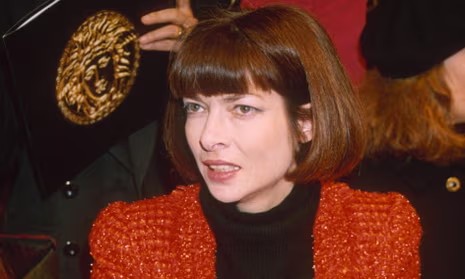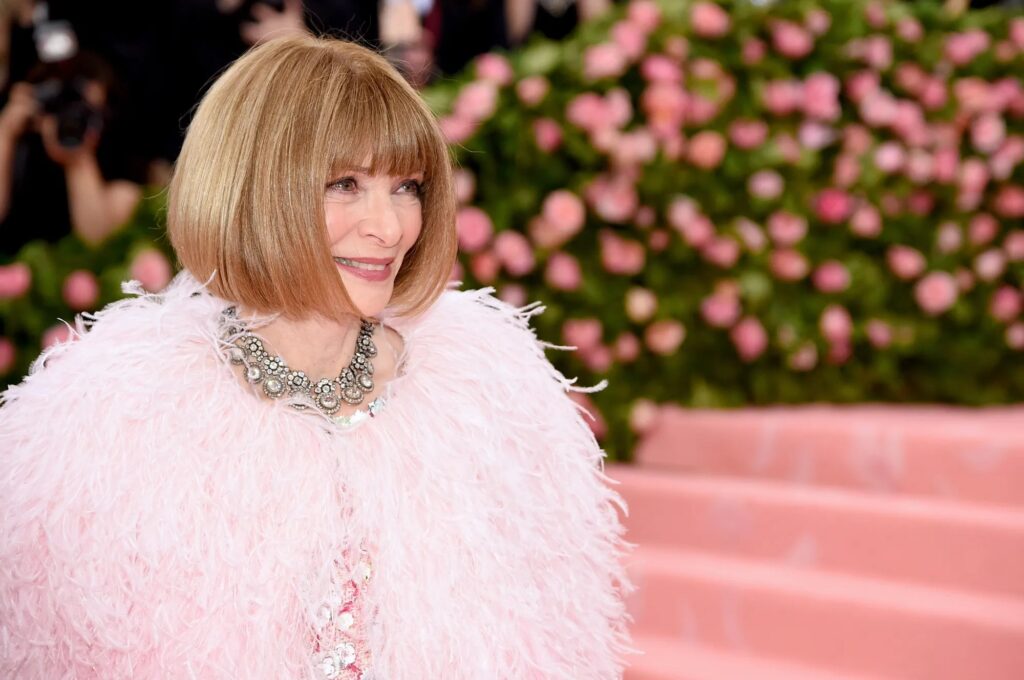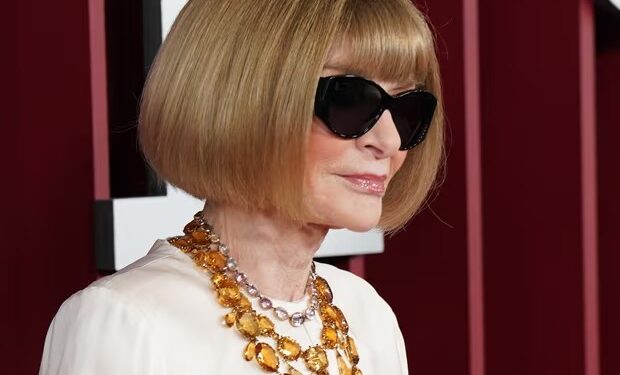After more than three decades at the helm of American Vogue, Anna Wintour is stepping down, marking the end of one of the most iconic and influential reigns in the history of fashion publishing. Her departure signals a turning point not just for the magazine, but for an entire industry shaped in her image.
For generations, Anna Wintour has been more than just the editor-in-chief of American Vogue — she has been its soul, its gatekeeper, its icon. With her signature pageboy bob, dark sunglasses, and glacial poise, she presided over the most powerful title in fashion media with an authority that seemed both absolute and eternal. But nothing lasts forever. This week, Condé Nast confirmed that Wintour will officially step down from her editorial duties, although she is expected to retain a more symbolic and advisory role within the company.
Wintour’s departure closes the chapter on an extraordinary editorial career that not only shaped the global image of American fashion but transformed Vogue into a cultural force spanning art, politics, and entertainment. Her tenure defined the aesthetics, values, and rhythms of modern fashion — and her absence will leave an unmistakable void.
The rise of a fashion monarch
Born in London in 1949, Anna Wintour came from media aristocracy. Her father, Charles Wintour, was a respected editor at the Evening Standard, and her early exposure to journalism and publishing formed the foundation of her career. After stints at Harper’s & Queen and British Vogue, Wintour moved to New York in the late 1970s and began to rise through the editorial ranks. Her bold vision quickly set her apart — she brought a European sensibility to the American market, fusing accessibility with edge, and commercial instincts with high art.
In 1988, she was appointed editor-in-chief of American Vogue, succeeding Grace Mirabella. From her very first issue — featuring model Michaela Bercu in a bejewelled Christian Lacroix jacket paired with faded jeans — Wintour made clear she was rewriting the rules. It was a declaration that high fashion no longer belonged only to runways and couture salons; it was meant to be lived in, played with, and democratised. This blend of luxury and approachability became Vogue’s signature under Wintour.
Vogue as cultural capital
Over the years, Wintour turned Vogue into more than a glossy magazine. It became a symbol of prestige, taste, and influence. Her editorial decisions — who graced the cover, which designers were profiled, what trends were highlighted — shaped the broader cultural conversation. The Vogue cover was not just a platform for supermodels but a coronation for actors, musicians, athletes, and political figures. Under Wintour, the magazine featured everyone from Michelle Obama to Kim Kardashian, Serena Williams to Rihanna.
She also championed the careers of designers who are now household names: John Galliano, Alexander McQueen, Marc Jacobs, Tom Ford, and more. Her support could make or break a designer’s career. Through initiatives like the CFDA/Vogue Fashion Fund, she institutionalised that influence by backing emerging talent with capital, mentorship, and exposure.
Wintour’s power was felt beyond the page. She was instrumental in founding the Met Gala as a global cultural event, transforming a once-modest museum fundraiser into the most important red carpet in fashion. Her ability to marshal celebrities, designers, and media into one spectacle underscored her unmatched social capital.
Criticism and contradiction
Despite her brilliance and lasting legacy, Wintour’s reign was not without controversy. She was criticised for promoting a narrow and often exclusive vision of beauty, with Vogue long favouring thin, white models and Eurocentric aesthetics. Although the magazine made efforts to diversify its representation in recent years, critics argued those changes were reactive rather than pioneering.
Internally, reports of a frosty and hierarchical culture under Wintour persisted for decades. She was described as demanding, unapproachable, and sometimes indifferent to changing workplace dynamics. Yet others lauded her decisiveness, her professionalism, and her vision — traits that enabled her to survive a media industry in constant flux.
She also faced scrutiny for her perceived political manoeuvring inside Condé Nast. As artistic director of the entire media group and later chief content officer, Wintour’s reach extended far beyond Vogue. Some accused her of consolidating too much power and stifling editorial independence across titles. Nonetheless, she remained indispensable, particularly as the print world struggled to navigate digital disruption.
Adaptation in the digital age
Wintour’s ability to survive — and thrive — in the shifting media landscape is perhaps the greatest testament to her brilliance. While other legacy editors were ousted or faded into obscurity, she continuously adapted Vogue for a younger, more digitally-savvy audience. She embraced social media, influencers, and fashion film. She expanded Vogue’s video production and oversaw the launch of platforms like Vogue Runway, which turned fashion coverage into a live-streamed, data-driven enterprise.
She also knew when to evolve her own editorial instincts. In the wake of global reckonings around race, gender, and representation, Wintour issued a rare public apology in 2020, acknowledging past failures and vowing to do better. Whether the gesture was sincere or strategic remains debated — but it illustrated a rare moment of vulnerability from a woman whose authority had long appeared impermeable.


Legacy beyond pages
Anna Wintour’s impact extends far beyond fashion. She has wielded significant political and philanthropic influence, raising millions for causes ranging from AIDS research to Democratic presidential campaigns. Her friendship with political figures, including Hillary Clinton and Barack Obama, positioned her as a power broker well outside the bounds of fashion media.
In the creative world, she became a sort of high priestess — immortalised in films, parodied in television, and mythologised in books. The Devil Wears Prada, loosely based on her, only amplified her mystique. Though she never publicly confirmed the film’s portrayal, insiders said she quietly embraced the notoriety it brought, knowing it only cemented her status as a legend.
Her mentorship has been quietly impactful as well. Generations of stylists, editors, writers, and publicists owe their careers to her. She trained them in the Wintour doctrine: precision, control, and a clear editorial voice. Even those who eventually rebelled against her influence acknowledged her role in their ascent.
What comes next
With Wintour stepping aside, the fashion world finds itself at an inflection point. Her exit coincides with larger conversations about what fashion means in the 2020s — and who it is for. Climate change, diversity, digital disruption, and shifting values have all challenged the industry’s old models of glamour, consumption, and exclusivity.
It is unclear who will take her place. Some speculate Vogue may split the role between editorial and commercial leadership, reflecting a more collaborative and decentralised future. Others wonder if the job, as Wintour defined it, is even possible anymore.
What is clear is that no single figure will ever again wield the kind of influence Wintour had. The media ecosystem is too fragmented, the cultural landscape too diffuse. Her legacy belongs to a time when magazines were bibles and editors-in-chief were gods.
The final curtain
As she exits the stage, Anna Wintour does so with her head high, her sunglasses on, and her control intact. Her departure is not a defeat, but a carefully choreographed handover. She leaves behind a Vogue that, while smaller in print circulation, remains a global powerhouse of fashion content, events, and branding.
More than a career, Anna Wintour embodied an era. She ruled with discipline, charisma, and often contradiction — making her not just the queen of fashion, but its most fascinating enigma. The industry she helped build will now have to navigate its future without her daily hand — and that reality is as thrilling as it is uncertain.
REFH – newshub finance



Recent Comments